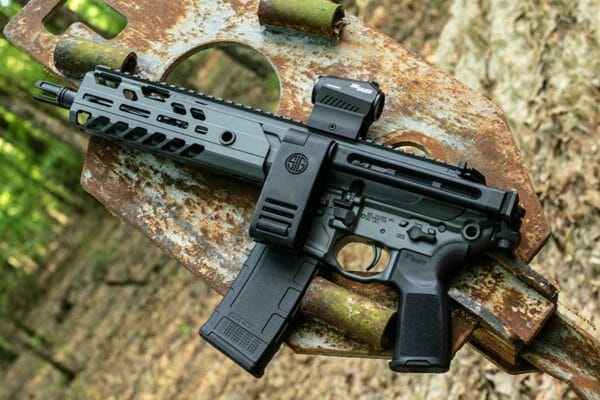
Gun Owners of America’s (GOA) preliminary injunction against the Bureau of Alcohol, Tobacco, Firearms and Explosives (ATF) rule on pistol stabilizing devices (Final Rule 2021R-08F) has been extended until the conclusion of the case.
The case, State of Texas v. ATF, was bought by GOA, Gun Owners Foundation (GOF), and the state of Texas to challenge the ATF rule that reversed years of determinations surrounding pistols equipped with stabilizing devices. The ATF’s new rule reclassified most pistols with stabilizing braces to short-barreled rifles (SBRs), meaning the firearms would be regulated under the National Firearms Act of 1934 (NFA). It required owners of these guns to register the firearms with the ATF, submit to additional background checks, hand over passport pictures, and provide fingerprints.
If the gun owners don’t want to register the pistol, the ATF gives them four choices. The first choice is to turn over the pistol to law enforcement. The second is to install a barrel greater than 16 inches. The third is to remove the brace and make it so it can never be installed again. The final choice is to destroy the firearm.
The rule set off a flurry of lawsuits asking for a nationwide injunction before the June 1, 2023, effective date. Second Amendment Foundation (SAF) would get an injunction in a Texas District Court. Firearms Policy Coalition (FPC) would get their injunction from the Fifth Circuit Court of Appeals. GOA’s injunction would also come from a Texas District Court—none of the injunctions applied to all gun owners. Only the members of the organizations were covered. The injunctions were issued before the cut-off date.
The injunctions would be used as stop gaps until later to give the courts time to rule on the cases. Judge Drew B. Tipton has now decided to extend the preliminary injunction until the case is settled. A preliminary injunction is an “extraordinary remedy” to maintain the status quo. Several factors have to be considered for an injunction to be issued.
The first and most important factor is the likelihood of the plaintiffs to succeed on the merits of the case. Judge Tipton cited the ruling in Mock v. Garland, where the Fifth Circuit Court of Appeals found that the ATF violated the Administrative Procedures Act (APA) by pulling a bait and switch with the Proposed Rule and the Final Rule.
The ATF presented a rule with a form (ATF Form 4999) with a point system to determine if a brace would turn a pistol into an SBR. When the Final Rule was unveiled, the point system was gone. All braces currently on the market would turn any pistol into an SBR if equipped. The rule bore no resemblance to the Proposed Rule.
“The first inquiry is whether a Plaintiff that has standing has established a substantial likelihood of prevailing on the merits. Id. The Fifth Circuit has already decided “that the Final Rule fails the logical-outgrowth test and violates the APA.” Mock, 75 F.4th at 578. Because that holding pertained to the ATF’s rulemaking process, any plaintiff challenging the Final Rule on APA grounds in the Fifth Circuit has the same likelihood of success. Therefore, Plaintiffs have a substantial likelihood to succeed on the merits of their logical-outgrowth claim,” Judge Tipton wrote in his 29-page decision.
The judge also believes the plaintiffs will suffer irreparable harm if the Court doesn’t issue an injunction. Judge Tipton pointed out that the plaintiffs would be forced to comply with ATF’s rule if no injunction is issued, meaning they would have to get rid of or modify their firearms.
“The ATF gave affected gun owners until May 31, 2023, to register their stabilizing braces. 88 Fed. Reg. at 6570. Because that deadline has now passed, complying with the Final Rule would require the private Plaintiffs to do one of four things: (1) permanently modify their weapon to remove it from the scope of the NFA, (2) dispose of or ‘alter’ their stabilizing brace so that it can never be reattached, (3) turn over their weapon to the ATF, or (4) destroy their weapon completely,” the order reads.
The final factor in a preliminary injunction is the balance of equities and public interest. In this stage, the judge explores the harm to the plaintiff if an injunction is not issued. The judge also looks to the harm caused to the defendant if an injunction is issued. The judge will then look at the public interest.
The judge ruled that the plaintiff would experience harm immediately without an injunction. He said the ATF’s harm is more administrative and speculative. Judge Tipton also ruled that “there is no public interest in the perpetuation of unlawful agency action.”
“The Court finds that the balance of equities tips in Plaintiffs favor because the Final Rule’s effect on Plaintiffs is immediate and imminent while the effect on Defendants, especially the ATF, is more administrative and speculative. Defendants’ arguments of harm to the public are unavailing,” the judge wrote.
The judge kept the scope of the ruling just to GOA members. This decision means that all GOA members will be protected from ATF enforcement actions over braced pistols for the foreseeable future. Even though there is no all-encompassing order enjoining the ATF from taking enforcement action against anyone who owns a pistol equipped with a stabilizing brace, the scale of the current injunctions means millions of Americans are protected from ATF action. Since none of the groups are required to share their membership rolls with the ATF, many believe the rule is currently unenforceable.
The ATF Final Rule on the classification of pistols equipped with stabilizing braces is not dead yet, but it is on life support.
GOA’s Injunction Against The ATF’s Pistol Brace Rule Extended Until The Case Is Settled by AmmoLand Shooting Sports News on Scribd
About John Crump
John is a NRA instructor and a constitutional activist. John has written about firearms, interviewed people of all walks of life, and on the Constitution. John lives in Northern Virginia with his wife and sons and can be followed on Twitter at @crumpyss, or at www.crumpy.com.

from https://ift.tt/GNH5njE
via IFTTT

No comments:
Post a Comment